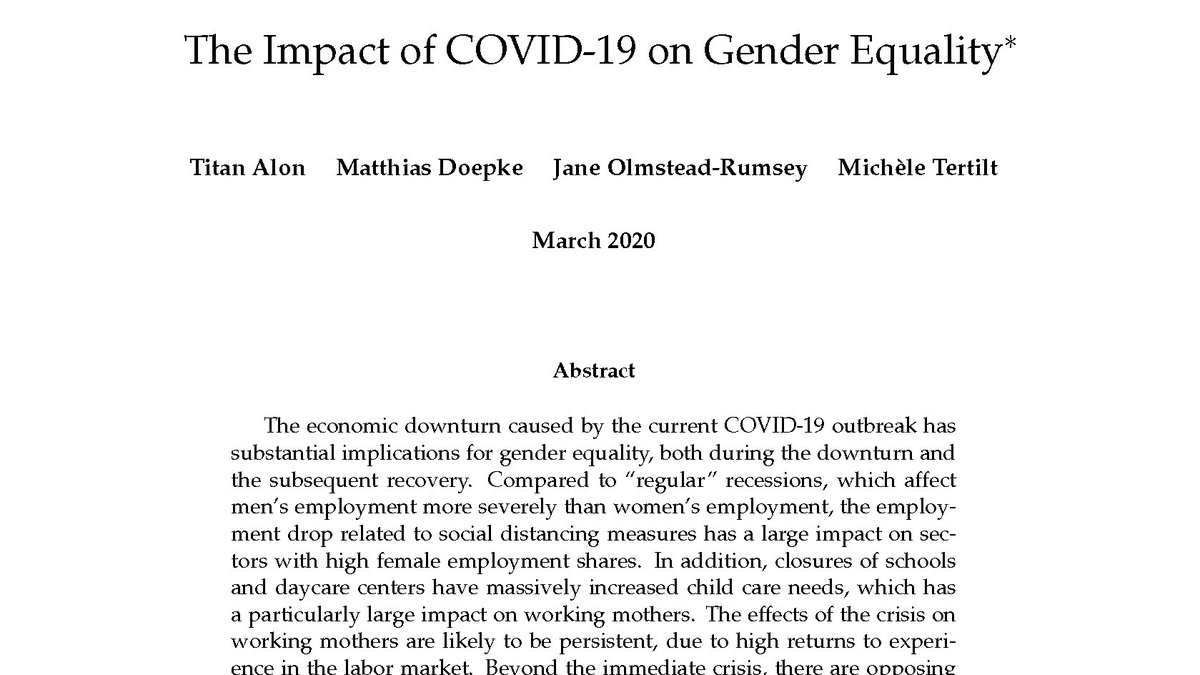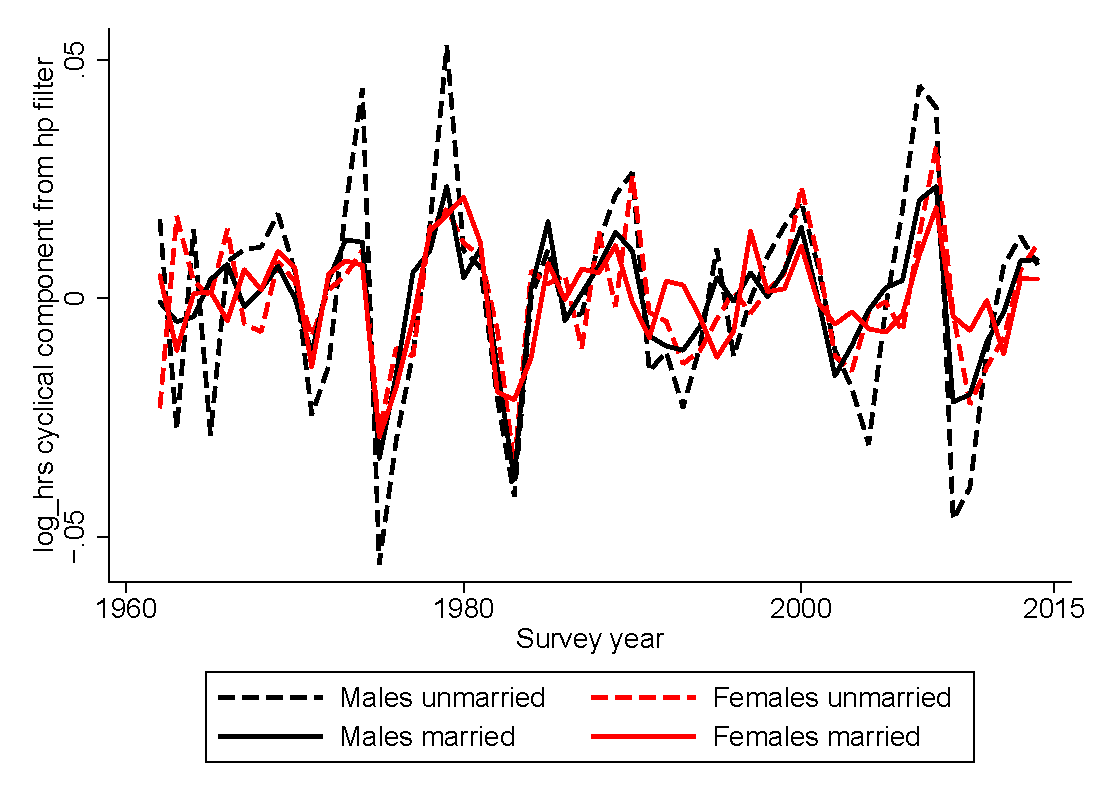A thread on #COVID19 and gender equality. Punchline:
Short run: crisis hits women much harder than men
Long run: women may gain from shifts in work organization and social norms
Based on new paper with @TitanAlon @janeor_econ @TertiltMichele:
https://bit.ly/3dvZqoJ ">https://bit.ly/3dvZqoJ&q...
1/N
Short run: crisis hits women much harder than men
Long run: women may gain from shifts in work organization and social norms
Based on new paper with @TitanAlon @janeor_econ @TertiltMichele:
https://bit.ly/3dvZqoJ ">https://bit.ly/3dvZqoJ&q...
1/N
Short run: The impact on employment
Background: Usual recessions hit men more than women, in part because many men work in cyclical industries such as construction and manufacturing. As a result, men’s employment is much more cyclical than women’s employment.
2/N
Background: Usual recessions hit men more than women, in part because many men work in cyclical industries such as construction and manufacturing. As a result, men’s employment is much more cyclical than women’s employment.
2/N
The #COVID19 recession is TOTALLY DIFFERENT! From today’s unemployment report:
“States continued to cite services industries broadly, particularly accommodation and food services.”
These are industries with high female employment shares.
3/N
“States continued to cite services industries broadly, particularly accommodation and food services.”
These are industries with high female employment shares.
3/N
Also, fewer women than men work in critical/essential occupations (17% vs. 24%), which will be more protected.
4/N
4/N
We also consider women vs. men’s exposure based on ability to telecommute, which varies substantially across occupations (from 3% of workers in transportation up to 78% in computing). Again, the numbers suggest that women’s employment will suffer at least as much as men’s.
5/N
5/N
2nd factor (even more important): CHILD CARE.
As schools and daycare centers close, children have to be cared for at home. With social distancing, grandparents and babysitters can’t help.
Who will care for all these children? Mostly mothers.
6/N
As schools and daycare centers close, children have to be cared for at home. With social distancing, grandparents and babysitters can’t help.
Who will care for all these children? Mostly mothers.
6/N
This is a worldwide issue: UNESCO estimates 1.5 billion students worldwide are currently out of school due to COVID-19 (close to 90 percent of the total).
https://bit.ly/2xw4AAn
7/N">https://bit.ly/2xw4AAn&q...
https://bit.ly/2xw4AAn
7/N">https://bit.ly/2xw4AAn&q...
In the United States, single parents will be especially hard hit by childcare needs. Only 20% have the ability to telecommute, compared to 40% of married people. Many can’t work now.
There are many more single moms than single dads!
8/N
There are many more single moms than single dads!
8/N
In the United States, 15.8 million kids live with single mother. Only 3.2 million live with single father.
https://bit.ly/2JfJs47
9/N">https://bit.ly/2JfJs47&q...
https://bit.ly/2JfJs47
9/N">https://bit.ly/2JfJs47&q...
Dual earner couples will also have trouble adjusting to sudden childcare needs.
Among couples who both work full time, women already provide more than 60% of all childcare, and are likely to shoulder the lion’s share of the increased burden.
10/N
Among couples who both work full time, women already provide more than 60% of all childcare, and are likely to shoulder the lion’s share of the increased burden.
10/N
Bottom line: In the short run, women’s employment will suffer much more than men’s. For many, this will lead to persistent earnings losses and lessened career opportunities in the future.
11/N
11/N
LONG RUN UPSIDE:
There are also gender equality bright spots.
1. WORKPLACE FLEXIBILITY.
Millions of businesses are adjusting to work from home. Through learning by doing and shifting norms, this will make combining careers and families easier in the future.
12/N
There are also gender equality bright spots.
1. WORKPLACE FLEXIBILITY.
Millions of businesses are adjusting to work from home. Through learning by doing and shifting norms, this will make combining careers and families easier in the future.
12/N
Given that women currently do a large majority of childcare work, they will benefit relatively more.
13/N
13/N
2. CHANGING SOCIAL NORMS
Based on work in critical sectors and ability to telecommute we estimate that during the crisis, husbands will become the primary provider of childcare in 8-12 percent of households with both spouses working full time.
14/N
Based on work in critical sectors and ability to telecommute we estimate that during the crisis, husbands will become the primary provider of childcare in 8-12 percent of households with both spouses working full time.
14/N
Millions of men will have greatly increased childcare responsibilities, often for the first time.
Experience (WW II, effects of paternity leave policies) suggests that this will permanently change the division of labor within the household by changing gender norms.
15/N
Experience (WW II, effects of paternity leave policies) suggests that this will permanently change the division of labor within the household by changing gender norms.
15/N
POLICY:
Despite the long run upside, the short run challenge is to support the millions of women who are out of options for work and childcare.
Our suggestions (some of which are already being implemented in some countries):
16/N
Despite the long run upside, the short run challenge is to support the millions of women who are out of options for work and childcare.
Our suggestions (some of which are already being implemented in some countries):
16/N
1. Replace 80% of pay for workers now off work because of childcare needs, conditional on continued employment relationship (i.e., can go back to work immediately after).
17/N
17/N
2. Lift all work requirements for government assistance programs, and don’t count current work interruptions towards future work requirements (e.g. 5-year TANF limit).
18/N
18/N
3. Extend unemployment insurance to workers voluntarily stopping work because of sudden childcare needs.
19/N
19/N
4. Universities: Extend tenure clock ONLY for faculty members with children under 14; similar provisions at other employers with up-or-out promotion systems.
20/N
20/N
Many more details in the full paper:
https://bit.ly/3dvZqoJ
/END
https://bit.ly/3dvZqoJ&q... href="https://twitter.com/TitanAlon">@TitanAlon @janeor_econ @TertiltMichele #econtwitter
21/21
https://bit.ly/3dvZqoJ
/END
21/21

 Read on Twitter
Read on Twitter



